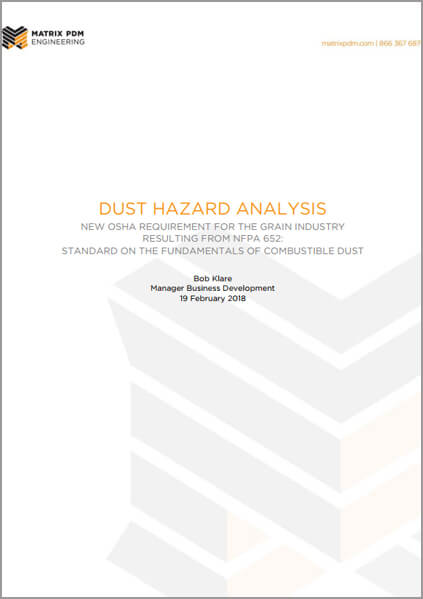Whitepaper: Dust Hazard Analysis
NEW OSHA REQUIREMENT FOR THE GRAIN INDUSTRY RESULTING FROM NFPA 652: STANDARD ON THE FUNDAMENTALS OF COMBUSTIBLE DUST by Bob Klare

BACKGROUND
Prior to 2016, the National Fire Protection Association (NFPA) had multiple industry-specific standards related to combustible dust. All of them were developed by separate committees, and they imposed a wide variety of requirements on various industries. To address this disparity, in 2016 NFPA issued a new standard, NFPA 652, Standard on the Fundamentals of Combustible Dust. This new standard created commonality among:
- NFPA 61, Agriculture and Food Processing Facilities
- NFPA 484, Combustible Metals
- NFPA 654, Combustible Particulate Solids
- NFPA 655, Sulfur
- NFPA 664, Wood Processing and Woodworking
One of the new requirements of NFPA 652 is the completion of a Dust Hazard Analysis (DHA) within three years by every facility that falls under these standards. Facilities can be exempted from this requirement by testing samples of their dust for combustibility and explosiveness, but that testing is not required. A facility can acknowledge that their dust is a known explosive and proceed from there. The grain dust standard, NFPA 61, was updated in 2017 to extend the deadline for grain facilities to complete their DHA until September 2020.
OSHA AND NFPA
The NFPA is a non-profit industry association with no ability to make or enforce laws or codes. However, OSHA incorporates NFPA standards under the General Duty Clause (Section 5(a)(1)) of the Occupational Safety and Health Act of 1970. As a result, companies found in violation of the NFPA standards can be cited under federal OSHA jurisdiction.
DUST HAZARD ANALYSIS
The DHA is a new requirement identified in NFPA 652, Chapter 7. Similar to Process Safety Management, it is a formal and systematic review of a facility and includes the following:
- Identification and evaluation of the process or facility areas where fire, flash fire, and explosion hazards exist, based on both NFPA 61, the grain standard, and the new requirements of NFPA 652, the combustible dust standard.
- Where such a hazard exists, identification and evaluation of specific fire and deflagration scenarios shall include the following:
- Identification of safe operating ranges
- Identification of the safeguards that are in place to manage fire, deflagration, and explosion events
- Recommendation of additional safeguards where warranted, including a plan of implementation
- Documentation of the findings of the DHA
The DHA needs to be performed or led by a qualified person, defined by NFPA as, “a person who, by possession of a recognized degree, certificate, professional standing, or skill, and who, by knowledge, training, and experience, has demonstrated the ability to deal with problems related to the subject matter, the work, or the project.” Matrix PDM personnel have the education and experience to meet this requirement, demonstrated through an engineering background and extensive design experience in the grain industry.
ADDITIONAL CONSIDERATIONS
NFPA 652 requires that all affected employees be trained on the findings of the DHA and all hazards present in their workplace, as well as existing or planned mitigation steps. The documented findings of the DHA will need to be available to employees and contractors, and will be required to be made available during an OSHA inspection.
The new mitigation and prevention requirements in the standard, except for completion of a DHA, are not applied retroactively to facilities and systems that existed at the time of the standard’s publication (January 2016) unless the facility or system undergoes material modification, defined as modifications valued at over 25% of the original cost.
When there is a specific technical conflict between NFPA 652 and any of the industry-specific standards, the industry-specific standard takes precedence. However, if a requirement is identified in NFPA 652 but is not addressed in the industry-specific standard, NFPA 652 takes precedence.
With the publication in 2017 of the revised grain dust standard, NFPA 61, two important potential conflicts with NFPA 652 were addressed:
- New explosion venting requirements for storage bins and silos do not apply if they are impractical because of silo geometry or building constraints.
- New explosion venting requirements for tunnels and pits do not apply if they are impractical because of confinement by soil or building constraints.
While facilities that were in operation before the publication of NFPA 652 are not required by the standard to comply with the new venting, isolation, or suppression systems, there are several reasons that facilities may still choose to implement the recommended additional safeguards:
- Their corporate safety policy may require elimination of identified hazards
- Their facility’s insurance carrier may require implementation
- They might be held liable under OSHA’s General Duty Clause if a hazard that they are aware of causes an accident or injury
- The standard gives authority to an AHJ (Authority Having Jurisdiction), which could be any code or standard enforcement body, to require retroactivity if the AHJ determines that the hazard is too great to ignore.
CONTACT US FOR MORE INFORMATION
Matrix PDM provides inspections and assessments of new or existing structures in the energy, power and industrial markets. We cover a diverse range and complexity of issues ranging from electrical and manufacturing, chemical and cement, food and grain, sulfur and marine.
Whether you need a trusted team to conduct your dust hazard analysis or modify your existing facility, the multidiscipline engineering professionals at Matrix PDM will use their decades of experience and industry knowledge to make your facility operate at its optimum level.
View the article as a PDF here.